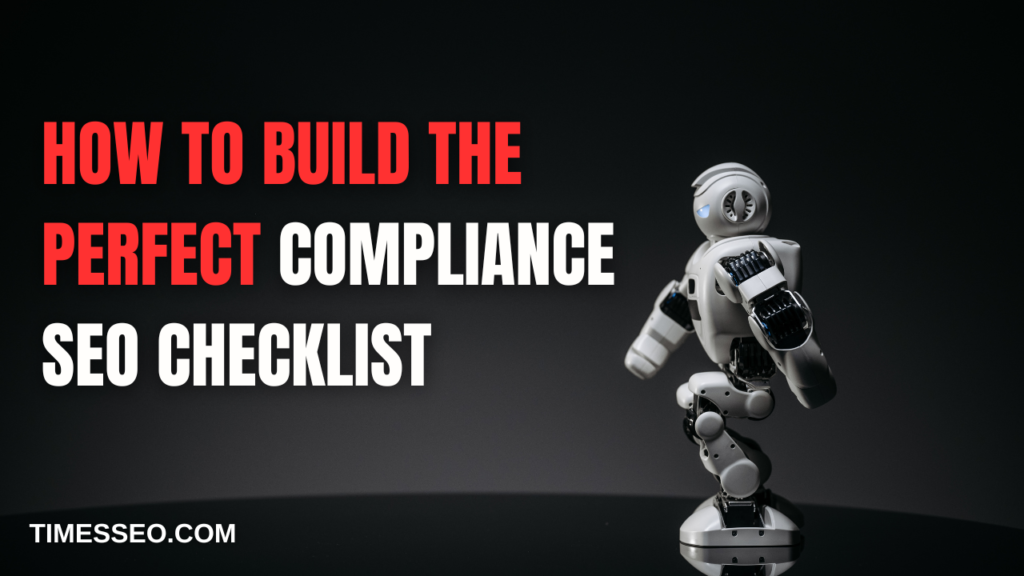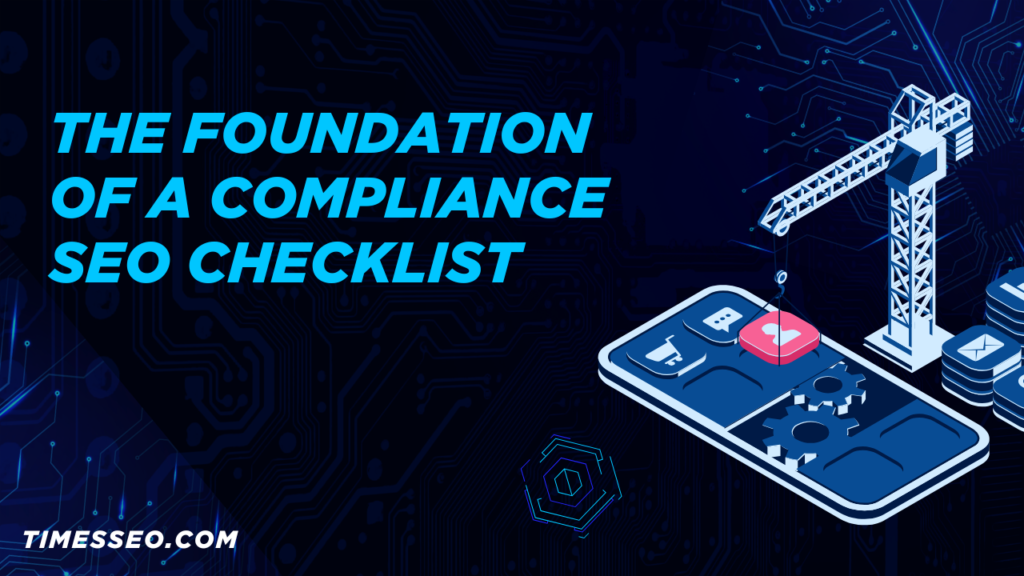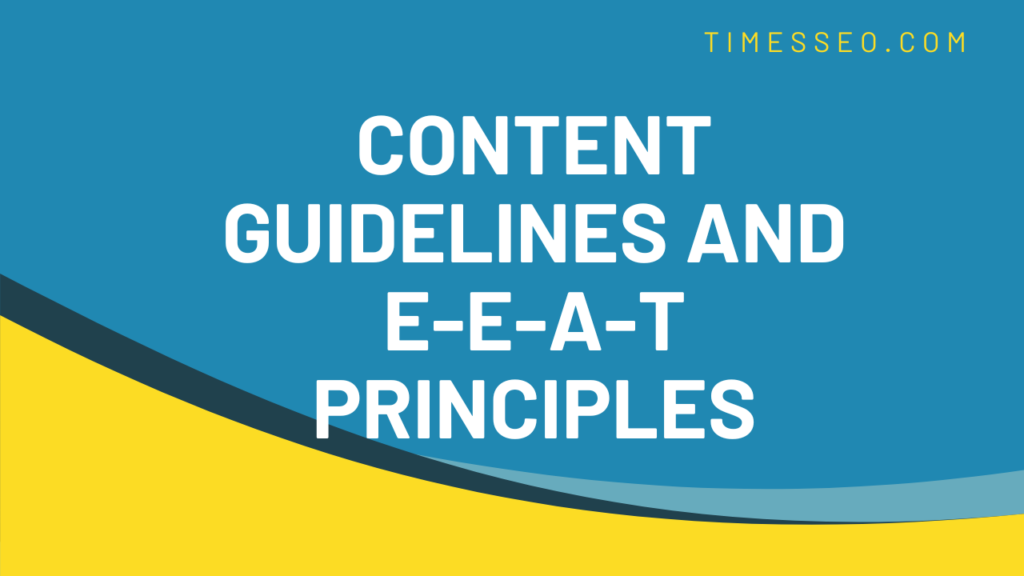
How to Build the Perfect Compliance SEO Checklist
Learn how to create a comprehensive compliance SEO checklist that ensures your website meets search engine guidelines, legal standards, and user experience best practices. This blog post breaks down every essential step — from technical SEO and content quality to accessibility and data privacy — helping you stay optimized and penalty-free.
Table of Contents
Introduction
What is SEO Compliance?
SEO compliance is all about making sure your website follows not just best SEO practices, but also legal, ethical, and search engine-specific guidelines. Think of it like crossing the street — you need to wait for the green light and look both ways. Just optimizing your site isn’t enough if you’re not compliant.
Why Is SEO Compliance Important?
Compliance ensures that your site avoids penalties, stays competitive, protects user privacy, and provides an inclusive experience. Plus, search engines love it — and when Google’s happy, your rankings rise.
The Foundation of a Compliance SEO Checklist
Aligning SEO with Legal Guidelines
From copyright laws to GDPR, there’s more to SEO than keywords. Use licensed content, avoid plagiarism, and respect intellectual property.
Meeting Industry Standards and Search Engine Policies
Whether it’s Google’s Webmaster Guidelines or Bing’s best practices, staying up to date helps keep your site out of trouble and on top of search results.
Website Structure and Technical SEO
HTTPS and SSL Certification
A secure site is a trusted site. Google prioritizes HTTPS websites, and SSL certificates are now a basic requirement for SEO.
Mobile Responsiveness
More than half of internet traffic is mobile. If your site isn’t mobile-friendly, you’re losing both users and search rankings.
Site Speed Optimization
No one likes a slow website. You can see where you need to make improvements using tools like Google PageSpeed Insights.
Core Web Vitals Explained
- Largest Contentful Paint (LCP) – Measures load speed
- First Input Delay (FID) – Measures interactivity
- Cumulative Layout Shift (CLS) – Measures visual stability
Off-Page SEO and Link Building Compliance
White Hat vs. Black Hat SEO
Black hat = shortcuts and tricks that may get you penalized. White hat = ethical strategies that work long-term.
Ethical Link Building Practices
Earn backlinks through quality content, guest posts, and real partnerships — not shady schemes.
Disavowing Toxic Links
Use Google’s Disavow Tool to keep bad backlinks from harming your domain authority.
On-Page SEO Compliance Factors
Meta Tags and Descriptions
These are your page’s elevator pitch. They should be unique, descriptive, and keyword-optimized — without being spammy.
Header Tag Hierarchy (H1 to H4)
Structure matters. A clear header hierarchy makes content easy to read for both users and bots.
Content Quality and Originality
Google is smarter than ever. If your content isn’t original or useful, it won’t rank.
Avoiding Duplicate Content
Avoid stealing content from other websites and make use of canonical tags. Even internal duplication can hurt your ranking.
Accessibility and ADA Compliance
Image Alt Text and ARIA Labels
Not only is accessibility morally right, it’s also great SEO. Use alt text for every image to help visually impaired users and boost search engine understanding.
Keyboard Navigation & Readability
Make sure your site is usable without a mouse and readable at all screen sizes.
Data Privacy and GDPR Compliance
Cookie Consent Banners
You’ve seen those annoying banners — and for good reason. GDPR requires you to inform users about data collection.
Privacy Policies & User Data Handling
Be transparent. Link your privacy policy clearly, and never collect personal data without consent.
Content Guidelines and E-E-A-T Principles
Demonstrating Experience and Expertise
Google wants content written by people who know their stuff. Show credentials, author bios, and real-world experience.
Building Authoritativeness and Trustworthiness
Cite sources, link to reputable sites, and maintain a clean online presence. Trust is everything.
Keyword Usage and Avoiding Over-Optimization
Natural Keyword Integration
Use keywords where they fit — not where they sound awkward. Read it out loud: does it sound natural?
Avoiding Keyword Stuffing Penalties
Stuffing your content with keywords is like over-salting your food. It ruins the experience and hurts your rankings.
Structured Data and Schema Markup
Implementing Rich Snippets
Want your page to stand out in search results? Add star ratings, costs, frequently asked questions, and more using schema.
Following Google’s Schema Guidelines
Stick to what’s supported by Google. Misusing schema can backfire with penalties.
Regular SEO Audits for Compliance
Monthly Technical Audits
Use tools like Screaming Frog or Sitebulb to scan for technical issues — broken links, missing tags, etc.
Tracking and Updating Content Regularly
Outdated content is useless content. Refresh posts, fix errors, and keep everything current.
Monitoring Tools for SEO Compliance
Google Search Console
Your best friend for compliance. Monitor indexing issues, mobile usability, and more.
SEO Compliance Tools
Tools like Ahrefs, SEMrush, and Moz can alert you to toxic links, duplicate content, and security issues.
Training Your Team on SEO Compliance
Creating SOPs and Training Manuals
Don’t leave it to chance. Standardize your compliance processes so your team follows the same rules.
Assigning SEO Responsibility Roles
Have a dedicated SEO compliance person or team responsible for regular reviews.
Staying Updated with SEO Policies
Following Algorithm Updates
Google updates its algorithm frequently. To keep up to date, read Google’s blog, Moz, and Search Engine Journal.
Joining SEO Communities & Blogs
Reddit’s r/SEO, LinkedIn groups, and SEO Slack channels can be goldmines for staying compliant.
Conclusion
SEO compliance is a way of thinking, not just a collection of rules. From legal regulations to algorithm updates, the landscape is always changing. But if you stay informed, act ethically, and continuously audit your site, you’ll build a solid SEO foundation that not only ranks but endures.
Frequently Asked Questions
Your site could be penalized, drop in rankings, or even be deindexed from search engines.
Ideally, conduct technical SEO audits monthly and content audits quarterly.
Absolutely! Compliance affects visibility, trust, and legal safety, no matter your business size.
Yes, aggressively stuffing keywords is against Google’s guidelines and can lead to penalties.
Accessibility — many websites still lack alt text and readable layouts, which affects both compliance and user experience.
Table of Contents
Popular Posts
-
 Affordable Technical SEO Audit for Small Business: A Complete Guide26 Jun 2025 Blog
Affordable Technical SEO Audit for Small Business: A Complete Guide26 Jun 2025 Blog -
 How to Get an Affordable Technical SEO Audit for Small Business27 Jun 2025 Blog
How to Get an Affordable Technical SEO Audit for Small Business27 Jun 2025 Blog -
 The Ultimate Local SEO Audit Checklist for Startups28 Jun 2025 Blog
The Ultimate Local SEO Audit Checklist for Startups28 Jun 2025 Blog -
 Local SEO Audit Checklist for Startups: A Beginner’s Guide28 Jun 2025 Blog
Local SEO Audit Checklist for Startups: A Beginner’s Guide28 Jun 2025 Blog -
 Top On-Page SEO Audit Steps for Service Websites Every Business Should Know29 Jun 2025 Blog
Top On-Page SEO Audit Steps for Service Websites Every Business Should Know29 Jun 2025 Blog -
 Technical SEO for WordPress: The Ultimate Beginner’s Guide01 Jul 2025 Blog
Technical SEO for WordPress: The Ultimate Beginner’s Guide01 Jul 2025 Blog -
 The Impact of On-Page SEO Audit Steps for Service Websites on UX01 Jul 2025 Blog
The Impact of On-Page SEO Audit Steps for Service Websites on UX01 Jul 2025 Blog -
 Technical Mobile SEO Audit Tips for Developers02 Jul 2025 Blog
Technical Mobile SEO Audit Tips for Developers02 Jul 2025 Blog -
 Complete SEO Backlink Audit Guide for Better Google Rankings03 Jul 2025 Blog
Complete SEO Backlink Audit Guide for Better Google Rankings03 Jul 2025 Blog -
 Boost Your Rankings with Technical SEO for WordPress01 Jul 2025 Blog
Boost Your Rankings with Technical SEO for WordPress01 Jul 2025 Blog






